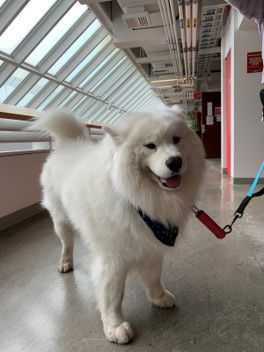Dog Leash Clasp for Individuals with Limited Hand Function
Yearlong Senior Thesis (2021-2022)
My thesis describes a dog leash clasp I designed and built for individuals with limited hand function. Currently available clasps are difficult to open (and stay open) which makes it hard for individuals with hand function issues to attach clasps to dog collars. The goal of the project was to build a clasp with a comfortable grip that could be easily opened and stay open so that it could be attached to a dog collar. The clasp was designed so that it was comfortable to use regardless of hand size and to withstand the forces of a large dog pulling on it.

Description
Exploded View of Clasp
1. A carabiner is used to attach the clasp to the dog leash
2. Body Part 2 is the main part which holds the entire clasp together and is what allows the slide to move properly
3. The spring launches the slide forward, closing or opening the clasp to attach to the dog's collar
4. Slide that holds the dog's collar in the clasp
5. Handle that allows for an easy grip to open and close the clasp
6. Body Part 1 is what holds the slide in place, this allows the clasp to be locked open or closed. Locking clasp allows the end user to let go of the clasp without worrying about it opening or closing when they do not want it to do so.
7. The hook attaches to the dog's collar. The hook is oversized so that the clasp is easy to use.

Manufacturing
After designing the parts in SOLIDWORKS, I manufactured the clasp in the various Harvard machine shops, using lathes, CNC mills, 3D printers, water jet cutters, and band saws.



Testing
Contact Pressure and Tension Testing
Since the clasp needed to be comfortable to grip, I tested to make sure there was ample padding on the final design (which was satisfied with 1/16 of an inch of foam rubber). This was tested with force sensitive resistors to ensure that the contact pressure while gripping was not too high (leading to an uncomfortable grip). However, much more exciting was the tension testing (to ensure that the maximum pull force of a large dog would not break the clasp). Put in an Instron tension tester (video to the right), it was pulled until failure, revealing that the clasp was 25x stronger than was required in the technical specifications! Future work could improve the clasp design by making it lighter as it was stronger than necessary.



